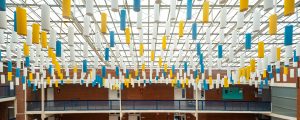What is Biophilic Design and Why is it Important: The Benefits of Bringing Nature Indoors
A growing trend known as biophilic design focuses on remodeling interior spaces to incorporate elements inspired by nature, mimicking and […]
08/08/2024
Grup Efebé
Environmental development and sustainability should be integral parts of daily life in schools, not just topics covered. We need to change our habits and create a sustainable school in itself. Environmental responsibility is no longer an option but an urgent necessity. Today, more and more families are seeking educational centers that meet sustainable standards and promote environmental education.
At Grup Efebé, we transform schools into sustainable learning environments to make these crucial changes a reality, enhancing the well-being of individuals and the planet every day.
Sustainable architecture refers to design and renovation projects that optimize natural resources to minimize environmental impact, adhering to energy efficiency criteria.
Sustainable design of educational spaces reduces energy consumption and improves the learning environment —as well as the well-being of students and staff— through the use of efficient and environmentally friendly techniques and materials. At Grup Efebé, we advocate for biophilic design in schools as a means of promoting environmental education and efficient natural resource management. We believe that sustainability should be part of the school’s culture and values in order to develop environmentally conscious and responsible citizens.
There are 6 principles of sustainability that we apply in our school renovation projects:

Acoustic Insulation at Escola Fundació Llor, in Sant Boi de Llobregat, Barcelona. Efebé’s Project. Photography: Joan Azorín.
Transforming schools into sustainable learning environments brings numerous benefits that extend beyond environmental impact.
By embracing these principles and making concerted efforts towards sustainability, educational centers can play a pivotal role in shaping a more sustainable future. Sustainable design in education not only benefits the environment but also creates healthier, more engaging and more productive learning environments for students. As we move towards a more eco-conscious world, schools must lead by example, teaching the next generation the importance of sustainability through both curriculum and practice. If you’re interested in transforming your educational center into a model of sustainability, contact us to learn how we can help make that vision a reality.
A growing trend known as biophilic design focuses on remodeling interior spaces to incorporate elements inspired by nature, mimicking and […]
“Neuroarchitecture aims to understand how our environment influences our brain and, as a result, our emotions and behaviors,” as noted […]
A sustainable office space is increasingly necessary to address environmental challenges, reduce energy consumption and promote the health and well-being […]
